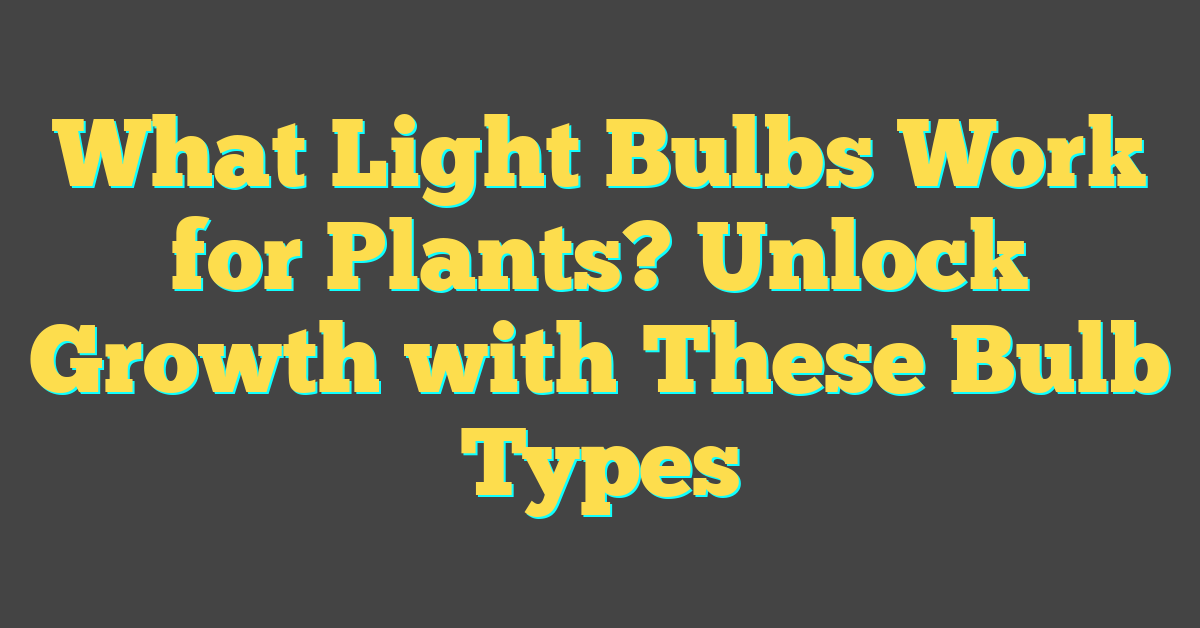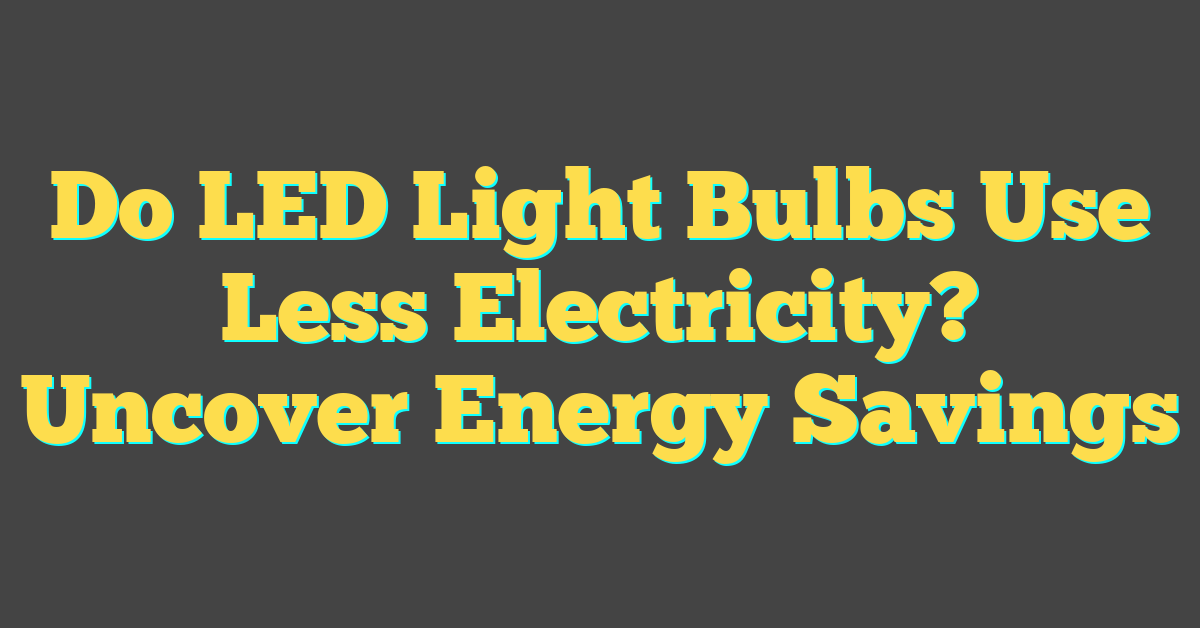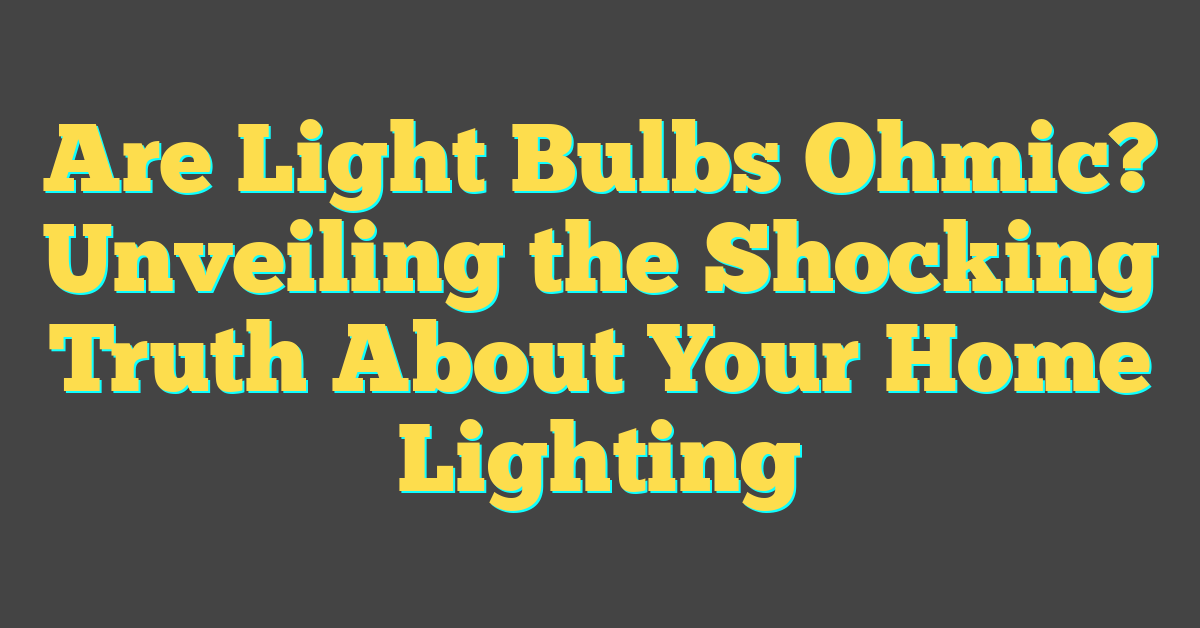Ever wondered why your indoor garden isn’t thriving as much as you’d hoped? The secret might just be hanging above your plants’ heads! Choosing the right light bulb can make all the difference in growing healthy, happy plants.

Let’s face it, not all light bulbs are created equal, especially when it comes to your leafy friends. From lumens to color temperature, the world of grow lights can be a bit overwhelming. But don’t worry, you’re about to get the lowdown on which bulbs will turn your indoor gardening game around.
Importance of Choosing the Right Light Bulbs for Plants
When dealing with the delicate balance of indoor gardening, every element counts—especially your choice in light bulbs. Photosynthesis is the cornerstone of plant health, and without proper light, your leafy friends may struggle to thrive. Selecting the right light bulb is not just about illuminating your space; it’s about matching the spectrum of light to the needs of your plants.
Fluorescent bulbs are often a go-to for gardeners because they emit a lovely full-spectrum light, which closely mimics natural sunlight. These bulbs are energy efficient and provide just the right amount of warmth without overheating your plants. But don’t be fooled by their simplicity—there’s a science to leveraging their benefits effectively.
- T5 fluorescent bulbs are ideal for small spaces and are popular for growing seedlings.
- Compact fluorescents work wonders for houseplants and herbs that don’t need intense light.
Your choice might be different if you’re tending to a variety of flora that demands more intensity. High-intensity discharge (HID) bulbs pack a punch and are perfect for plants that require a more robust light source. They come in several types, including:
- Metal Halide (MH) – Produces a cooler, blueish light perfect for vegetative growth.
- High Pressure Sodium (HPS) – Emits a warmer, red light ideal for the flowering stage.
The emerging favorite for many indoor gardeners is LED lights. LEDs are unique because they consume less energy and last longer than conventional bulbs. Perhaps their biggest draw is the ability to tailor the spectrum of light. You can find LEDs designed for various plant growth stages, from seedling to bloom, which ensures a tailored approach to each plant’s needs.
Remember, the goal is not just to shed light on your plants, but to provide them with the specific type of light that drives photosynthesis efficiently. Consider factors like the size of your indoor garden, the growth stage of your plants, and your budget when making your choice. With a bit of research and the right bulb, you’ll see your indoor garden flourish.
Understanding Lumens and Color Temperature

When you’re delving into the world of indoor gardening, mastering the concepts of lumens and color temperature is crucial. Lumens measure the total amount of visible light emitted by a source. In layman’s terms, it’s the brightness you perceive. For your indoor plants, higher lumens mean more light energy for photosynthesis, which is the lifeblood for their growth.
However, not all light is created equal. The lights in your home that make a cozy reading nook won’t necessarily support a thriving garden. That’s where color temperature comes into play. Measured in Kelvin (K), color temperature refers to the hue of the emitted light. Here’s a quick guide:
- 2700K – Warm white, akin to incandescent bulbs
- 5000K – Daylight, which resembles noon sunlight
- 6500K – Cool white, similar to overcast daylight
For most indoor greenery, you’ll want to aim for that daylight range (5000K – 6500K). This spectrum is akin to the natural light your plants would soak up if they were basking outdoors under the sun’s full, midday glory. Your choice of bulb should mimic this to provide the ideal conditions for your plant’s photosynthetic process.
It’s also smart to consider the varying needs of your plants through different growth stages. Seedlings require gentle light whereas mature plants might demand high-lumen, daylight-colored illumination. Investing in adjustable lighting solutions can save you from the hassle of constantly changing bulbs as your plants grow.
Whether you’re a seasoned indoor gardener or just starting out, understanding the nuanced dance of lumens and color temperature will empower you to make informed decisions about your lighting setup. Pay attention to the specific requirements of your plant species and adjust accordingly – they’ll thank you with robust growth and vitality.
Incandescent Bulbs and their Effects on Plant Growth

You might remember incandescent bulbs as the traditional light bulbs that graced many a lamp in your childhood home. However, when you’re diving into the world of indoor gardening, understanding how these bulbs impact plant growth is crucial.
« What Causes Light Bulbs to Blow? Avoid These Common Mistakes
How to Use Light Bulb in Farmville 2: Boost Your Harvest Now »
Incandescent bulbs generate light through a filament that’s heated until it glows. This process isn’t just inefficient—it’s tough on your energy bills. They convert less than 10% of the energy they use into visible light, with most of it dissipating as heat. Now, why should you care? Because that heat can stress or even harm your beloved plants if placed too close.
While incandescent bulbs do emit a broad spectrum of light, their red and far-red wavelengths prevail. This light flavor can promote flowering in plants, which sounds great at first. But, for germination and vegetative growth, you’re looking for a bulb that leans more towards the blue end of the spectrum.
Here’s a snapshot of how incandescent bulbs compare to other plant-friendly lighting options:
| Light Source | Efficiency | Spectrum | Heat Emission |
|---|---|---|---|
| Incandescent | Low | Broad, skewed to red | High |
| Fluorescent | Moderate | Broad, balanced | Low |
| LED | High | Customizable | Very Low |
Though they’re not the most efficient or plant-optimized lighting solution, incandescent bulbs can be used for specific purposes. A small wattage bulb might serve as a supplemental heat source for some tropical plants. They can also be part of a more complex lighting setup, providing additional wavelengths that other bulbs may lack.
Your indoor garden’s success lies in striking a perfect balance. If you decide to use incandescent lights, monitor your plants closely—watch for how they react to the heat and light and tweak your setup accordingly. Experimentation is key, especially when you’re nurturing growth through the colder months or dealing with particularly finicky species.
Remember, as you curate your lighting mix, it’s about choosing the right tool for the job. Each plant species has its preferences and it’s up to you, the savvy indoor gardener, to find light bulb harmony.
Fluorescent Bulbs: A Viable Option for Indoor Gardens

When you’re exploring lighting for your indoor garden, you can’t overlook fluorescent bulbs. They’ve got a lean toward the blue end of the light spectrum, which is the sweet spot for promoting lush, leafy growth and strong roots—exactly what your budding greens crave.
Unlike their incandescent cousins, fluorescent bulbs generate minimal heat. This allows you to position them closer to your plants without the fear of leaf burn—a common mishap for the unwary gardener. What’s more, they’re more energy efficient, which is kind to your wallet and the environment.
Here’s a quick breakdown of why fluorescent lights could be your go-to:
- Broad Spectrum: While not as targeted as LEDs, they offer a good mix of blue and red wavelengths.
- Low Heat Output: Reducing the risk of burning sensitive plants.
- Energy Efficiency: They consume less power than incandescent bulbs over time.
There’s a variety in the fluorescent family too. You’ve got your T5, T8, and T12 tubes. The T5s, with their slim profile and intense output, are a favorite among indoor gardeners. They’re especially good for starting seeds or small spaces.
Compact Fluorescent Lights (CFLs) are another option. They screw into a standard light socket, which makes them an easy fit for a DIY indoor garden. The spiral bulbs may look whimsical, but they’re workhorses when it comes to supplementing natural light for your plants.
| Fluorescent Bulb Type | Diameter | Efficiency |
|---|---|---|
| T5 | 5/8 inch | High |
| T8 | 1 inch | Medium |
| T12 | 1.5 inches | Low |
Whether you’re working with a full-fledged indoor greenhouse or a cozy herb corner in your kitchen, dipping your toes into the world of fluorescent lighting might just be the bright choice that leads your plants—and your green thumb—to thrive. Remember, integrating the right light involves observing how your plants respond and adjusting accordingly. Keep tweaking until your indoor oasis flourishes under that glowing canopy.
The Power of LED Grow Lights

After exploring the realm of fluorescent lighting, you’ll likely be intrigued by the advancements in LED (Light Emitting Diode) technology and its implications for your indoor garden. LEDs have revolutionized the way plant enthusiasts think about grow lights. LED grow lights are known for their efficiency and longevity. These fixtures boast an impressive life span, often lasting up to 50,000 hours. They are a phenomenal choice if you’re looking for lights that require minimal replacement and upkeep.
LEDs also stand out because they offer a full spectrum of light, which means they simulate natural sunlight more closely than other artificial lighting options. This not only supports overall plant health but can also encourage flowering and fruit production in a variety of plant species.
Here’s what you need to know about LEDs for plant growth:
- Precise Wavelengths: LED lights can be tailored to emit specific wavelengths of light, ensuring that your plants get exactly what they need for photosynthesis.
- Energy Efficiency: LEDs use less electricity compared to traditional grow lights, so they’ll ease the strain on your electricity bill.
- Low Heat Output: With LEDs, the risk of overheating your plants plummets. They generate significantly less heat, which means you can place them closer to your plants without worrying about damage.
Furthermore, as you dive into the DIY side of things, you’ll find that installing LED grow lights can be quite straightforward. Many models come with user-friendly mounting options, making them a breeze to integrate into your current setup.
As you consider transitioning to or incorporating LED grow lights into your setup, keep an eye on:
- Light Intensity: Measure how much light your plants are receiving and adjust the height as needed.
- Coverage Area: Ensure your LED grow lights cover the entire area where your plants are growing.
- Quality Brands: Invest in reliable brands known for high-quality grow lights to avoid the disappointment of a dim or ineffective light source.
Remember, light is just one piece of the indoor gardening puzzle, and it’s crucial to integrate it with other elements like water, nutrition, and ambient temperature. Keep experimenting and watching your plants—they’ll let you know if the light is just right.
Conclusion
So you’ve got the scoop on what bulbs can make your plants thrive. Remember, it’s all about matching your green friends with the right light and then watching them grow. Whether you choose fluorescent for that leafy goodness or LEDs for their custom vibes and cool touch, you’re on the right track. Just don’t forget to play around with placement and intensity to find that sweet spot. Happy gardening, and here’s to your indoor oasis flourishing under the perfect glow!
Frequently Asked Questions
What are the benefits of fluorescent bulbs for indoor gardening?
Fluorescent bulbs provide light that is rich in the blue spectrum, which is ideal for fostering leafy growth and strong roots. They also produce low heat, which reduces the risk of damaging plants, and are more energy-efficient than traditional incandescent bulbs.
Can fluorescent bulbs be placed close to indoor plants?
Yes, due to their minimal heat generation, fluorescent bulbs can be positioned closer to plants without the risk of causing leaf burn.
What types of fluorescent bulbs are suitable for indoor gardens?
For indoor gardens, T5, T8, and T12 fluorescent tube lights are common options. Compact fluorescent lights (CFLs) are also suitable for small-scale indoor gardening.
Why are LED grow lights considered efficient for indoor gardening?
LED grow lights are highly efficient because they consume less energy, have a long lifespan, and can provide tailored wavelengths of light to meet the specific needs of plants. They also emit very little heat.
Is it important to consider light intensity and coverage area when selecting LED grow lights?
Yes, it’s crucial to consider light intensity and coverage area to ensure your plants receive sufficient light. Choosing a reliable brand is also important to guarantee quality and effectiveness.
How should indoor lighting be integrated with other plant care elements?
Indoor lighting should be part of a balanced approach to plant care, which includes proper water, nutrition, and control of ambient temperature. Observe how your plants respond and adjust your strategy accordingly to optimize growth.




